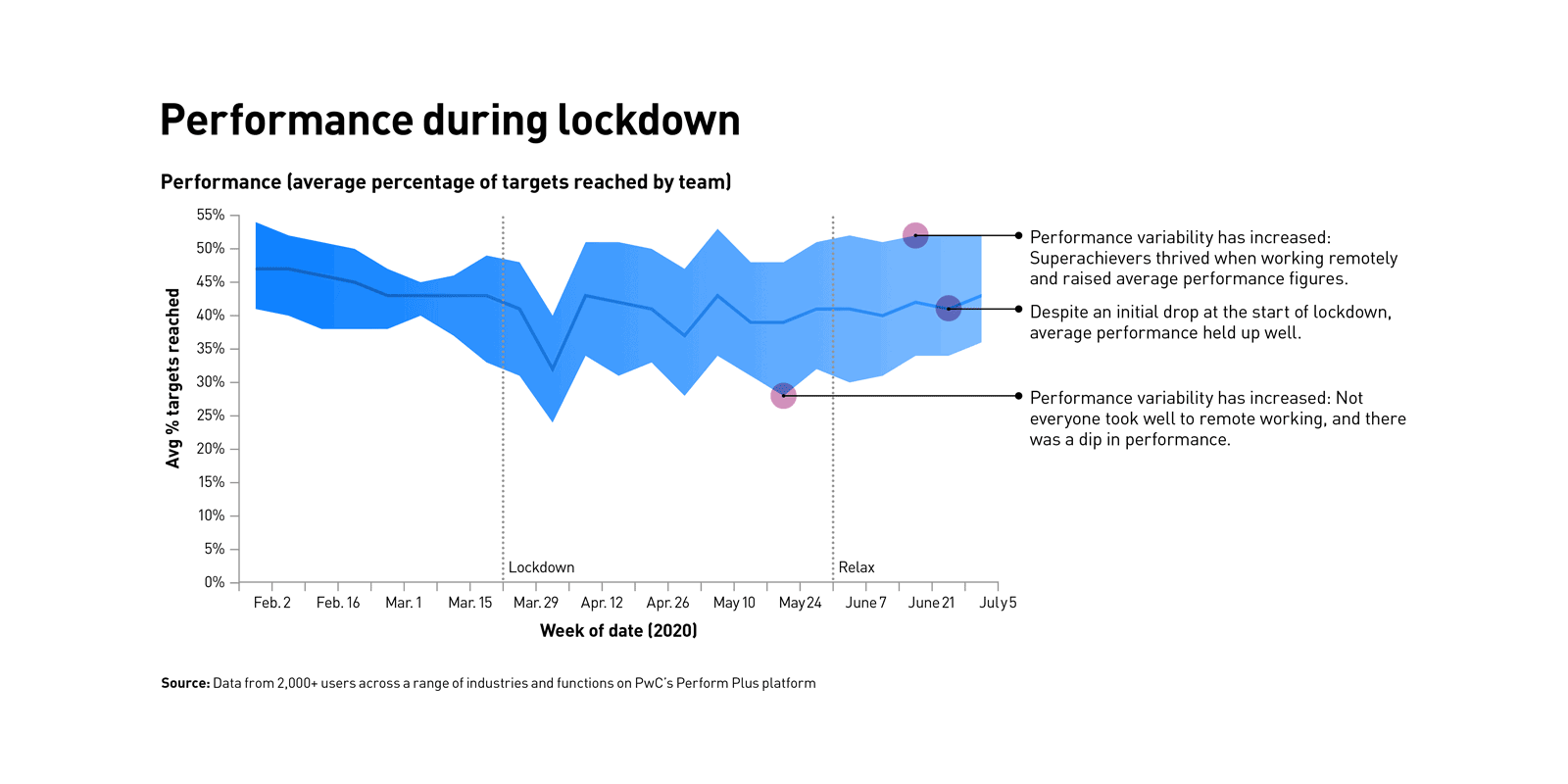Sustaining productivity in a virtual world
Maintaining productivity levels among remote employees is an enduring challenge. Here are five ways to help people and businesses thrive in the post-pandemic world of work.
A version of this article appeared in the Winter 2020 issue of strategy+business.
How was lockdown for your teams? Are they feeling stressed and isolated? Or has working from home turned out to be a productive, commute-free, work-in-comfy-clothes revelation? One thing seems certain: This global, flexible-working experiment has changed our professional routines, probably for good. In PwC US’s Remote Work Survey, conducted in June, 39 percent of U.S. executives said most of their office employees were working remotely at least one day a week before the pandemic. But during the COVID-19 crisis, almost everyone who could work exclusively from home did so.
Our research found that three-quarters of executives judged the forced experiment a success, contrary to the expectations of many. Data collected at the beginning of the lockdown and through the more recent opening-up phase of the pandemic shows that productivity, despite an initial drop, soon improved during lockdown and got back on track (see “Performance during lockdown”). This finding is backed up by our spring surveys of chief financial officers; in March, 63 percent of business leaders were concerned that remote working would result in lost productivity, but by June, this number had fallen to just 26 percent.
The bottom-line results show steady or increased productivity — that’s the solid line in the exhibit showing an uptick — which on first reading looks like good news, but those results hide a potential problem that appears when you look harder at the data. There is greater variation around mean performance in the weeks after lockdown than before: The blue bands start widening as lockdowns are enforced. This suggests that productivity has been propped up by a cohort of superachievers (around one-third of the total sample), which has disguised a fall in productivity among the rest.
These superachievers have worked harder and longer than before in the exceptional circumstances of the pandemic — perhaps because they have benefited from fewer distractions, or have fed off the adrenaline of the crisis. The rest of the employees found things more difficult; remote working doesn’t suit everyone, for practical or emotional reasons or a combination of the two. This breeds stress and fatigue, which present risks to engagement, performance, and mental health. “I’m feeling Zoomed out” is a familiar lament. The challenge for leaders is to find ways to tackle performance, because they cannot rely on superachievers to keep making up the shortfall for much longer.
This analysis comes from data collected from more than 2,000 users of Perform Plus, a tool developed by PwC that helps drive daily discussions on team and individual performance, which also includes an emphasis on well-being. The tool does this through the use of gamification and visual dashboards, and also records how people connect with one another and how they are feeling about their work through daily check-ins. This data is collected and analyzed to monitor trends, and the insights can trigger important dialogues with employees. Understanding what is going on in this way helps leaders develop strategies that fit the needs of their business and their people as they repair, rethink, and reconfigure their workforce to avoid potential pitfalls ahead.
The key question about the productivity data is whether it is sustainable as people start returning to work in the coming months, when businesses will see more of their people working from home as part of a hybrid model when the COVID-19 crisis has largely passed. We don’t think it is, unless leaders take direct steps to address the differences in performance among employees. To do this, they will have to invest in the underlying systems and processes that will help teams work in a productive and engaged manner. Here are five key points for businesses and leaders to bear in mind when developing ways to make remote working a success and sustain performance and engagement.
Define the right set of KPIs. Effective performance management of remote workers calls for holistic indicators; key performance indicators (KPIs) aren’t simply a matter of sales calls made or reports filed. Business KPIs that track both productivity (in terms of output) and effectiveness drive focus and accountability within the team, but well-being and collaboration KPIs should be added too. They can help predict productivity, or provide early warnings when people are feeling strained.
These well-being and collaboration metrics could include measures such as the number of touch points between teams, or individuals’ mood levels, or how people are coping with their workload. Well-being and happiness, of course, mean different things to different people, so the data isn’t a definitive measure — but it can open up a discussion for people to explain and explore (if they wish) the reasons they’re not feeling great, and allow for the option of getting support.
Create a connected team. Regular meetings help maintain a connected team and sense of community, even when people are working remotely. In fact, our data suggests that remote workers actively seek out opportunities to connect — we observed a rise in collaborative activity of more than 20 percent among Perform Plus users in the weeks following lockdown.
Frequent touch points create opportunities to discuss performance, well-being, priorities, and any issues at hand, as well as to celebrate successes. In the Perform Plus tool, daily “huddles” of just 15 minutes allow participants to review the key metrics that matter most.
The U.K. workforce of business software provider Sage, which includes around 1,000 customer-facing employees, switched to remote working in March. They had also been using Perform Plus for more than a year, and after the switch, the tool helped teams retain their “community way of working” during lockdown. “They may have been working from home, but there was still a tight connection within the team,” said Jon Cummins, VP of services and customer success at Sage, which is headquartered in Newcastle, England. The huddles that formed the core of the platform were held virtually. “This meant that ideas could still be shared, and people could ask their colleagues how they were dealing with specific situations. It meant that a sense of isolation didn’t develop and permeate the business,” Cummins said. The results were encouraging. According to Cummins, “Productivity increased for customer service teams over that time, [according to] the customer satisfaction measures we use, and we saw the mood of the vast majority of our people improve or remain at a strong level.”
Develop the role of leaders. Leading a remote team requires a strong emphasis on specific leadership skills — such as empathy, the ability to foster a sense of community, and the employment of digital skills that maximize the use of technology — and this should be recognized in leadership training and development. Team leaders may need specific coaching in order to successfully manage underperformers; for example, it’s far more challenging to hold a difficult conversation remotely.
The challenge for leaders is to find ways to tackle performance, because they cannot rely on superachievers to keep making up the shortfall for much longer.
Some leadership skills in a remote environment are more esoteric, but no less important. Remote workers need to feel a sense of empowerment in order to give their best, for instance. Leaders will need to create an environment in which teams take ownership of their work and of their preferred working style when they are away from the office.
Organizations will need to adapt their leadership development strategy in order to create leaders who can bring out the best among their remote teams. This development strategy should also recognize the different demands placed on leaders in this new environment; adding recovery time to schedules and monitoring the well-being of high performers will be essential in the months ahead.
Build in positive recognition. Regular recognition not only helps maintain a positive working culture, but is also an important driver of productivity. Recognition becomes even more important in a remote environment in which managers don’t have access to the physical and verbal clues they might pick up on in the office, and there are now fewer “watercooler” opportunities to provide on-the-spot acknowledgment. Leaders should identify fresh occasions to express recognition, tailored to individuals in a meaningful and genuine way. Technology can help here through techniques such as gamification: Performance leader boards or competitions with prizes can encourage desired behaviors.
Use structure to deflect distractions. Even before lockdown, our data suggested that as much as 30 percent of a team’s time was spent on non-value-adding activities. There is a risk this percentage could increase in a new hybrid work environment as a result of home distractions, child care, and the tendency of some to feel burned out after a long day of virtual conference calls. Building clear structure into team schedules — such as short daily catch-ups, focused time for specific activities, and breaks — helps support the focus of a dispersed team.
Technology has given us the opportunity to collect data on well-being and collaboration, and to make a connection between those data points and productivity. But it can do so much more. The data indicates that not everyone found lockdown to be a productive or happy period. That’s actionable information that managers can use to help people adjust.
The hybrid working model is likely to be the new reality, and people will have to adjust as new working habits emerge. The winners in this new virtual world will be those organizations that successfully navigate the specific challenges of managing remote teams. The variation in productivity levels during lockdown suggests that current performance levels are unsustainable because they rely on superachievers pulling up the average, but the five points outlined will help organizations and their leaders maintain and improve productivity and engagement levels for everyone as we move into this new world of work.
Author profiles:
- Nele Van Buggenhout specializes in operational excellence and workplace behaviors. Based in London, she is a director with PwC UK.
- Soraya Murat specializes in the design and delivery of transformation programs, with a focus on performance improvement. Based in London, she is a manager with PwC UK.
- Tom de Sousa is a data scientist, focused on combining human performance and process data to bring statistical insight to the workplace. Based in London, he is a senior associate in the artificial intelligence practice with PwC UK.




